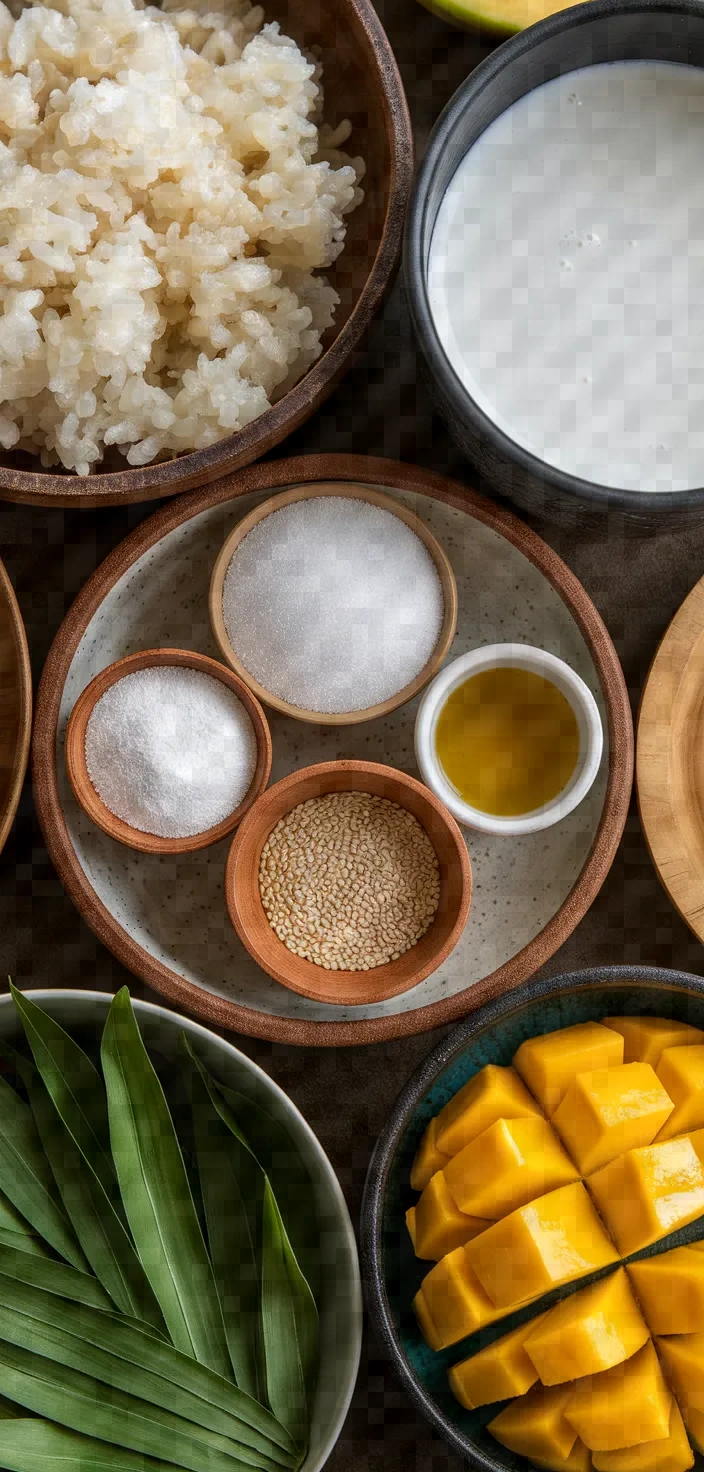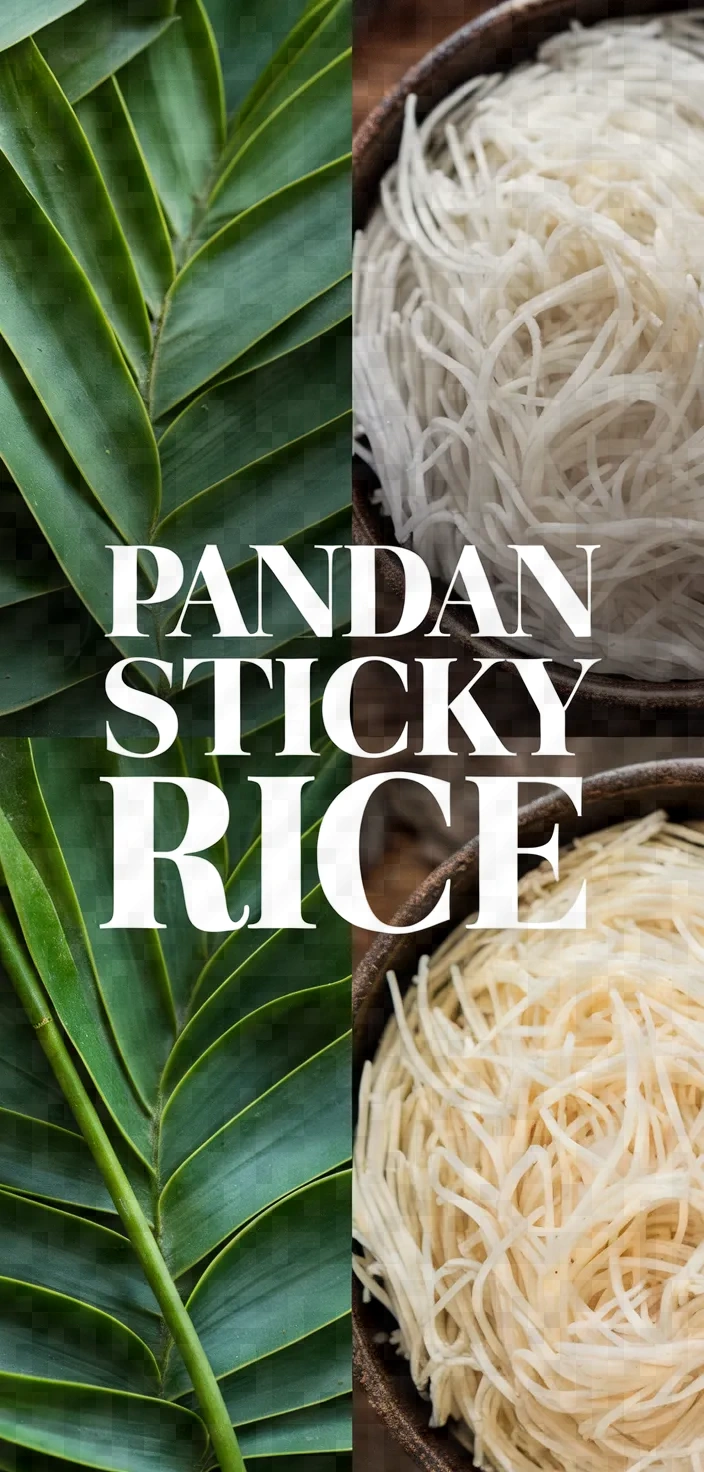I absolutely adore this pandan sticky rice recipe because it combines the creamy richness of coconut milk with the aromatic allure of pandan, creating a dessert that’s both comforting and exotic. Plus, it’s like a tropical getaway in a bowl, especially when topped with juicy mango slices and crispy sesame seeds!

Pandan sticky rice is a delightful Southeast Asian dish that I adore for its aromatic creamy flavors. It is made with 2 cups of glutinous rice and 1/4 cup pandan juice, a fragrant infusion that makes this treat so incredibly special.
It is really the addition of 1 1/2 cups of rich coconut milk that takes the flavor and texture to the next level. Just a touch of 1/4 cup sugar and 1/2 teaspoon salt balance everything out.
My favorite way to serve pandan sticky rice is garnished with toasted sesame seeds, along with either fresh mango slices or a dollop of coconut milk ice cream.
Ingredients

Glutinous Rice:
High in carbohydrates; provides the dessert with its sticky texture.
Coconut Milk:
Rich and creamy, it lends a nuanced sweetness and deep flavor.
Sugar:
Balances the flavors of coconut and pandan by sweetening the dish.
Pandan Juice:
Delivers the sweet scent of vanilla; imparts a natural olive-green coloration.
Pandan Leaves:
Utilized in steaming for an enhanced aroma and flavor infusion.
Ingredient Quantities
- 2 cups glutinous rice
- 1 1/2 cups coconut milk
- 1/4 cup sugar
- 1/2 teaspoon salt
- 1/4 cup pandan juice (made from blending pandan leaves with water)
- Pandan leaves, for steaming
- Optional: toasted sesame seeds, for garnish
- Optional: Mango slices, for serving
Instructions
1. Wash the glutinous rice in cold water until the water runs clear. It is preferable to use a bowl or basin that is not too deep. First, fill the basin with water. Place the rice in the basin and use your hands to agitate the rice; the water should get cloudy and full of starch. Drain that water. Repeat the process of filling the basin, agitating the rice, and draining the water until the water runs clear. After rinsing, soak the rice in cold water for at least 4 hours or overnight.
2. Soak the rice for a sauce that achieves this beautiful green color and also imparts a distinct flavor. Combine the soaked rice with pandan juice in a large bowl.
3. Cover the bottom of a steamer with pandan leaves, then spread the rice, which has been coated, evenly over the top.
4. Cook the rice using a steamer over medium heat for approximately 20-25 minutes or until completely done. Be certain to keep the lid of the steamer tightly sealed during cooking.
5. In a saucepan, mix together the coconut milk, sugar, and salt. Place over low heat; stir occasionally until the sugar completely dissolves. Make sure it does not come to a boil.
6. After cooking the rice, move it to a big bowl and slowly drizzle in the mixture of coconut milk. Stir the rice and the absorbed liquid together. Do this gently so as to not break up the grains but with enough energy that the liquid gets thoroughly mixed in.
7. Allow the rice to sit, covered, for about 15 minutes. This lets the flavors meld together.
8. Use a fork to fluff the sticky rice and distribute the coconut milk thoroughly.
9. To serve, you can optionally garnish with sesame seeds that have been toasted and serve next to fresh slices of mango, if you wish.
10. Relish the fragrant pandan sticky rice as a delicious dessert or sweet treat!
Equipment Needed
1. Large bowl or basin
2. Steamer with lid
3. Saucepan
4. Mixing spoon
5. Fork
6. Measuring cups
7. Measuring spoons
8. Knife (for optional garnishes)
9. Cutting board (for optional garnishes)
FAQ
- What is glutinous rice?Sticky rice, also known as glutinous rice, is a kind of rice grown mainly in East and Southeast Asia. When it is cooked, the rice has a consistency that makes it both sticky and slightly chewy—is there any better rice for making Pandan Sticky Rice?
- How do I make pandan juice?To create pandan juice, mix some pandan leaves with water and extract the juice by straining the mixture.
- Can I use regular rice instead of glutinous rice?No, regular rice won’t get as sticky as what you need for this dish. The texture of the finished product is entirely dependent on glutinous rice. In fact, using glutinous rice is what makes this dish so special.
- Is it necessary to use pandan leaves for steaming?If you can’t find it, you can skip using pandan leaves. You may still make a totally delicious sticky rice dish. But if you want the best authentic flavor, you really should use pandan leaves.
- Can I substitute pandan juice with pandan extract?Indeed, using a small amount of pandan extract is a good option, provided you don’t have access to fresh pandan leaves. Extracts are concentrated forms of the plant, so you would adjust down in quantity from what you would use if you were working with the fresh plant.
- How should I serve Pandan Sticky Rice?You can serve it warm or at room temperature, often with fresh mango slices, and you can sprinkle it with toasted sesame seeds for some added flavor. Or don’t—it’s delicious enough on its own.
- What is the purpose of coconut milk in the recipe?Adding colors, flavors, and textures to enhance the enjoyment of food is the essence of cooking. When it comes to the simplest of dishes—for instance, a pot of rice, which is often served as an accompaniment in Asian cuisines—that is the culinary mindset to which the cook aspires. Coconut milk enriches the sticky rice with creaminess and flavor, making it more delicious and adding to its authentic taste.
Substitutions and Variations
If you want a sticky rice, similar to that of glutinous rice, use short-grain sushi rice. It has a texture that is close to what you want. For me, the flavor is a little too pronounced when using rice vinegar for the typical sushi flavor in the vinegar mixture, but Ellen happened to have some milder rice vinegar on hand that worked just fine. Sally Schwartz, doing a test for Bon Appétit years ago, indicated that you can get pretty good flavor in these things, and I believe her.
For an alternative to coconut milk that is free from dairy, use almond milk. However, be mindful that doing so will change the flavor.
Replace white sugar with coconut sugar or brown sugar for a deeper molasses flavor.
In the absence of pandan juice, one may use several drops of pandan extract; however, this is a concentrated form of the ingredient, and one should use it judiciously.
If steaming with pandan leaves is impossible, banana leaves can offer a comparable aromatic effect.
Pro Tips
1. Use Fresh Pandan Leaves: For the best flavor, ensure you’re using fresh pandan leaves when making the pandan juice. Fresh leaves will provide a more vibrant color and a stronger, more authentic pandan aroma.
2. Optimize Rice Soaking Time: When soaking the glutinous rice, let it soak overnight if possible. This will help achieve a better texture and cook the rice more evenly, making it sticky but not mushy.
3. Even Steaming: To ensure even cooking in the steamer, avoid overcrowding. Spread the rice in a thin, even layer over the pandan leaves. Stir the rice gently halfway through steaming to promote even cooking.
4. Coconut Milk Temperature Control: When heating the coconut milk mixture, do it over low heat, stirring frequently to prevent curdling. The mixture should be warm and smooth, not boiled, for optimal absorption into the rice.
5. Mango Selection: If you’re serving the sticky rice with mango, choose ripe, sweet mangoes to complement the rich and fragrant pandan rice, enhancing the overall flavor experience.

Pandan Sticky Rice Recipe
My favorite Pandan Sticky Rice Recipe
Equipment Needed:
1. Large bowl or basin
2. Steamer with lid
3. Saucepan
4. Mixing spoon
5. Fork
6. Measuring cups
7. Measuring spoons
8. Knife (for optional garnishes)
9. Cutting board (for optional garnishes)
Ingredients:
- 2 cups glutinous rice
- 1 1/2 cups coconut milk
- 1/4 cup sugar
- 1/2 teaspoon salt
- 1/4 cup pandan juice (made from blending pandan leaves with water)
- Pandan leaves, for steaming
- Optional: toasted sesame seeds, for garnish
- Optional: Mango slices, for serving
Instructions:
1. Wash the glutinous rice in cold water until the water runs clear. It is preferable to use a bowl or basin that is not too deep. First, fill the basin with water. Place the rice in the basin and use your hands to agitate the rice; the water should get cloudy and full of starch. Drain that water. Repeat the process of filling the basin, agitating the rice, and draining the water until the water runs clear. After rinsing, soak the rice in cold water for at least 4 hours or overnight.
2. Soak the rice for a sauce that achieves this beautiful green color and also imparts a distinct flavor. Combine the soaked rice with pandan juice in a large bowl.
3. Cover the bottom of a steamer with pandan leaves, then spread the rice, which has been coated, evenly over the top.
4. Cook the rice using a steamer over medium heat for approximately 20-25 minutes or until completely done. Be certain to keep the lid of the steamer tightly sealed during cooking.
5. In a saucepan, mix together the coconut milk, sugar, and salt. Place over low heat; stir occasionally until the sugar completely dissolves. Make sure it does not come to a boil.
6. After cooking the rice, move it to a big bowl and slowly drizzle in the mixture of coconut milk. Stir the rice and the absorbed liquid together. Do this gently so as to not break up the grains but with enough energy that the liquid gets thoroughly mixed in.
7. Allow the rice to sit, covered, for about 15 minutes. This lets the flavors meld together.
8. Use a fork to fluff the sticky rice and distribute the coconut milk thoroughly.
9. To serve, you can optionally garnish with sesame seeds that have been toasted and serve next to fresh slices of mango, if you wish.
10. Relish the fragrant pandan sticky rice as a delicious dessert or sweet treat!
